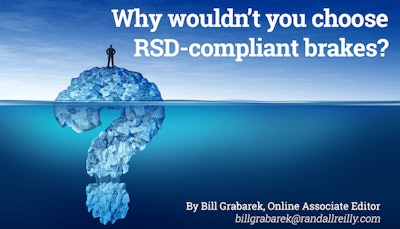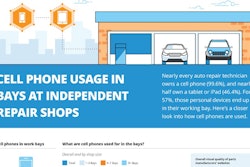
“It’s not personal; it’s strictly business,” goes the second-most famous line from “The Godfather” film. But when it comes to brake systems, when does a business’ bottom line undermine safety?
I began asking myself that question as I was working on a two-part feature that ran in Trucks, Parts, Service (TPS) earlier this month. The topic was on reduced stopping distance (RSD) brakes.
Some quick background: The National Highway Traffic Safety Administration published a final rule amending Federal Motor Vehicle Safety Standards No. 121. The rule was implemented in two stages, but the first stage, effective Aug. 1, 2011, covered nearly all heavy-duty trucks and mandated that those built after the effective date be able to stop within 250 ft. after traveling 60 MPH while loaded to their gross vehicle weight rating.
The rule required significant reengineering by the OEMs, but the TPS story focused on aftermarket brakes because truck owners are not bound by the final rule to replace OEM brake components with RSD-compliant ones.
“It comes down to replacing what you have with what I call genuine or OE-equivalent parts to maintain the performance of the vehicle, in general, from not only the friction side of things, but the balance, the stability and the control of the vehicle,” Randy Petresh, Haldex vice president, technical services, told TPS.
But, while working on the story, I was a little alarmed by what a couple aftermarket distributors told me about their customers’ preferences. One distributor said 50 percent of vehicles manufactured with RSD-compliant brakes are replaced with RSD brakes. That percentage sounded startingly low to me until another distributor said its percentage was around 20 percent. Again, this was a decision made by the truck owners.
Why wouldn’t any truck owner replace their RSD-compliant brake system with RSD-compliant components instead of less expensive brakes, which could result in greater stopping distance, poorer performance, a greater safety risk and increased liability?
One reason is the cost differential.
I understand fleets trade in a lot of trucks and getting the least expensive brakes installed on trucks they plan to trade in soon would save them a ton of money. Couple that with the hypothetical, but not altogether unrealistic, thought process of: “If the new owner wants better brakes on his used truck, he can pay for them.”
To be frank, I don’t get it. I write a lot about business and industry — and have for more years than I care to count — but, admittedly, I’ve never run a business (college accounting courses made sure of that). So, feel free to explain to me the rationale. Am I just being Pollyannaish to think replacing RSD-compliant brake materials with the same type is just the right thing to do, regardless of the bottom line?
Another reason truck owners don’t ask for RSD-compliant components is they might be unaware of the rule. Luckily, there are aftermarket distributors and manufacturers out there not only willing, but go out of their way, to explain the benefits with their customers in person and on their company websites.
Unfortunately, like the old proverb states, “You can lead a horse to water, but you can’t make it drink,” and parts and service providers and brake manufacturers can only do so much. They can explain to customers the advantages of replacing like for like all day long but they can’t make the customer buy what is more beneficial to them.
Wheelco Product Manager Jerry Podhradsky sums it up well: “It really comes down to safety and deciding what’s best for your company or fleet if you want your equipment to perform as close to the same braking standards as when you purchased the truck new.”










